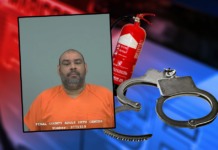A hard gray plastic table and four folding chairs are the only furnishings in the 6′ by 12′ room.
In one of those chairs is Maricopa Street Crimes Unit Sgt. Ed Alameda and, as florescent light seeps in from a small window set in the door, he explains why he can’t be photographed.
“I don’t want suspects knowing who I am,” he said.
Alameda’s street crimes unit was formed four months ago with a focus on gangs in Maricopa, but since then it has grown to include burglaries, auto thefts, graffiti, narcotic activity and any other crime of growing concern.
“This unit gives us the ability of hyper focus on the hot spots,” said police spokesperson Sgt. Stephen Judd.
The division typically pours through crime reports with the help of the department’s crime analyst and attempts to spot trends.
Typically, when a crime is committed, an officer comes out and does an initial investigation, but he may not have information on a similar crime that occurred down the street, Judd said. “This division focuses on spotting the trends and linking multiple crimes to a single suspect,” Judd said.
Once a trend is spotted the unit will hit the streets to gather information through interviews and surveillance with the members of the unit trying their best to keep a low key presence, regularly changing their clothes and vehicles.
“If I need to dress up as a bush with flowers to gather information, I will,” Alameda said. “I like to be invisible.”
It is techniques like these that have led to the division making 33 felony arrests in its first three full months of operations.
Some of the higher profile arrests in that time span have been the hole in the wall burglars and a group that had burglarized the state Route 238 RV Storage.
“It wasn’t only my division that made these arrests possible, but the work of the department as a whole,” Alameda said. “We just helped link all the information together.”
Alameda shared an example of this linking ability, which came in the division’s first month of existence, in an interview. Two of his detectives were at the house of a person suspected in a burglary when one of the detectives noticed the pattern on a pair of shoes in the corner matched an imprint from a burglary three months prior. “We got the person to confess to not only the burglary we were there investigating, but the one three months earlier also,” Alameda said. “Criminals never just commit one crime and quit.”
In addition to the information the division receives from other officers in the department, Alameda is quick to point out a key component to solving crime is community members who call in suspicious activity.
“We may have a community member call in the plate number of a suspicious vehicle and then two days later a burglary in the same neighborhood occurs. We now have a lead because of the concerned resident,” he said.
The room Alameda is sitting in typically is used for interviewing suspects. It is here he and his two detectives have extracted multiple confessions and numerous pieces of information that led to subsequent arrests.
However, he won’t reveal his department’s interview tactics.
“We have been very successful in getting confessions and information, but I cannot tell how,” Alameda said. “When my guys get on the scent, bad guys beware.”

![SR 238 closures start tomorrow SR 238 [File]](https://www.inmaricopa.com/wp-content/uploads/2022/04/az-238_e_seq_034-218x150.jpg)








![Merging lanes incite more 347 anger A merging lane sign sits on the side of State Route 347 northbound lanes during evening traffic on April 30, 2024. [Monica D. Spencer]](https://www.inmaricopa.com/wp-content/uploads/2024/04/spencer-043024-adot-merging-lanes-347-web-218x150.jpg)



![SR 238 closures start tomorrow SR 238 [File]](https://www.inmaricopa.com/wp-content/uploads/2022/04/az-238_e_seq_034-100x70.jpg)


